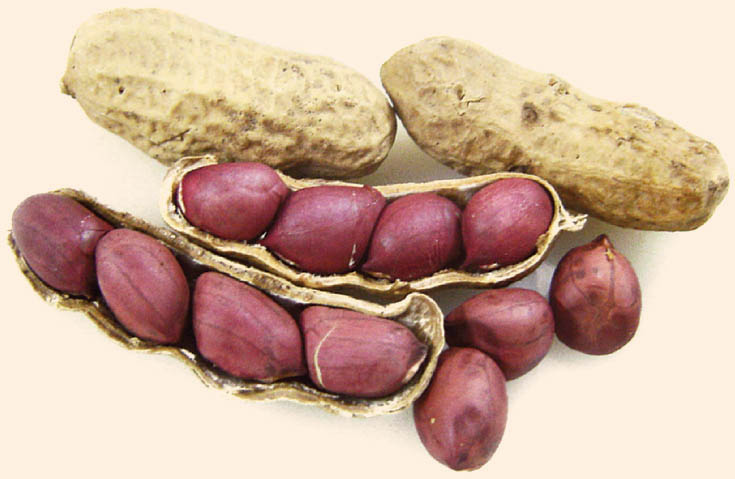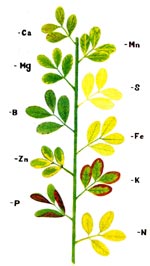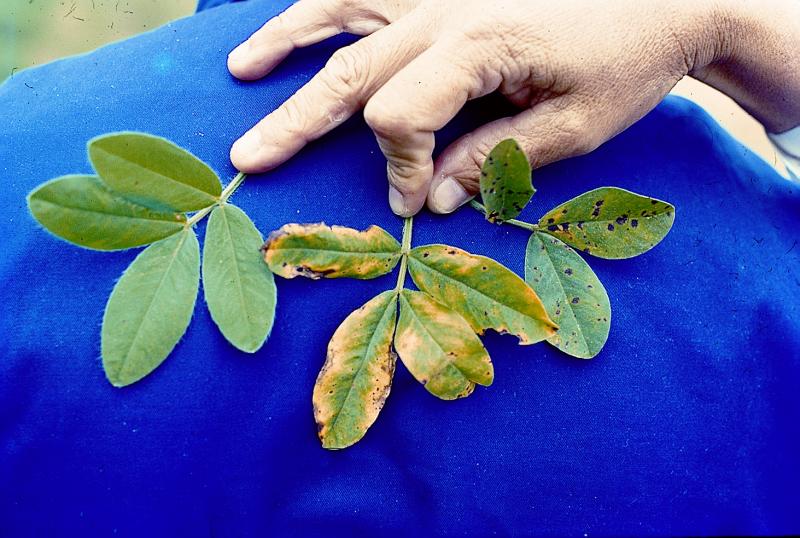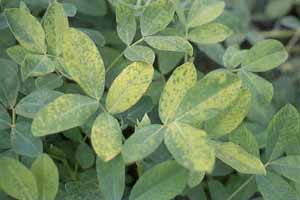
Crop: Groundnut
Scientific name : Arachis hypogeal L.,
Common / Local Name : Bhikna/ Moong phali

In Goa, groundnut was introduced way back in early seventies under the 20point Programme.
From a negligible area then, today this important oilseed is being cultivated in both the seasons covering an area of over 4500ha. The area under kharif is relatively less (550ha) as compared to the rabi season (4200ha).Although the productivity of kharif groundnut during kharif is about 1300kg/ha, the productivity under typical rice fallow residual moisture conditions is quite high (1800kg/ha) and is second only to West Bengal. However, the Frontline demonstrations conducted since 1990s in major groundnut areas has resulted in yield levels ranging between 2300 -2400kg/ha.
Field should be ploughed and cross ploughed to bring to a fine tilth up to a depth of 25-30cm.
Generally two ploughings followed by two harrowings in criss- cross direction will bring the soil to a fine tilth. Deep ploughing is advantageous in rainfed areas because of better retention of moisture and improvement in soil porosity. It leads to better management of soil borne pathogens and enhanced nutrient availability In sandy and sandy loam soils, the best practice is to undertake soil planking as soon as ploughing of soil is undertaken after collecting and removing rice stubbles.
Groundnut is sown in between second fortnight of June and first fortnight of July in kharif depending upon the onset of monsoon. In Goa however, the area under kharif is roughly 500 ha and is limited to three or four talukas like Pernem, Canacona, Bicholim. The major area (more than 4000 ha) is taken up in rabi season mainly as a sequential crop in rice fallows under the residual moisture conditions. The most ideal time for rabi sowing is between last week of November to second fortnight of December. Sowing groundnut in January under residual moisture conditions exposes the crop to moisture stress resulting in poor plant stand. However, wherever facility of irrigation source is available, the crop can be sown from January to February. Maintenance of optimum plant population is the key to success in groundnut cultivation. The seed rate depends up on the variety and spacing. The most common spacing for Spanish (erect) cultivar is 30x10cm. At this spacing, the seed requirement works out to be 100-110 kg kernels/ha to obtain a plant population of roughly 3.33lakh plants/ha. In semi spreading or spreading varieties like the confectionery types, the most common recommended spacing is 45cmx10cm which requires 95-100kg kernel/ha to get a population of 2.22lakh plants /ha.
The seeds need to be treated with efficient strain of Rhizobium before planting. For this, about 375-500 g of Rhizobium culture can be mixed with the seeds required for an hectare through the use of rice paste or any other gummy substances so as to get a uniform coating on the seed. The depth of sowing is also crucial specially in sandy soils for uniform germination. The sowing should be done 3-4 cm deep and well covered with soil.
Sl |
Variety |
Duration |
Yield Potential |
1 |
Dh-3-30 |
100-105 |
22-24 |
2 |
Dh-40 |
115-120 |
20-22 |
3 |
Dh-86 |
110-115 |
19-20 |
4 |
TAG-24 |
110-115 |
23-24 |
5 |
TG 37/A |
115-120 |
24-26 |
6 |
Asha* |
130-145 |
32-34 |
7 |
TPG-41* |
125-130 |
30-32 |
Groundnut being legume, needs more phosphorous, being an oilseed crop needs more sulphur and it needs more calcium for proper shell formation and pod filling. To produce one tonne pods/ha groundnut requires about 58kgN,5 kg of P and 18kg K,11kg calcium,4 kg sulphur and 9kg of Magnesium. To sustain the overall health of the soil and continued good yields, a desirable level of organic carbon in the soil (0.3 -0.7%) must be maintained. Application of organic matter (Farm Yard Manure,(FYM) compost, green manure or crop residues) to the soil is a must for supplying organic carbon. Well decomposed farm yard manure or compost @8-10 tonnes/ha should be applied well before sowing and should be immediately incorporated into the soil. Organic manures are good source of micronutrients also. Inoculation of efficient strains of Phosphate Solubilizing bacteria (PSB) culture species like Pseudomonas striata and Bacillus polymixa with the seed increases availability of phosphorous from the soil and thus improves yields. The inoculation of seed with PSB should be done as has been described for Rhizobium and both can be mixed together and applied simultaneously. For obtaining high fertilizer use efficiency, inorganic fertilizers should be applied on the basis of soil test results. However, based on field experiments the recommended NPK doses are indicated below. The recommended fertilizer dose for groundnut crop under Goa condition is 20kgN, 50kg P2O5 and 30kg K2O/ha. in addition to 250 kg Gypsum/ha once in three years.
Nutrient deficiency and its management in Groundnut
Nitrogen

Deficiency symptoms |
Management |
|
|
Phosphorus
Deficiency symptoms |
Management |
|
|
Potassium 
Deficiency symptoms |
Management |
|
|
Sulphur
Deficiency symptoms |
Management |
|
|
Zinc
Deficiency symptoms |
Management |
|
|
Iron

Deficiency symptoms |
Management |
|
|
Boron
Deficiency symptoms |
Management |
|
|
On an average, groundnut crop requires about 550-650 mm of water depending up on the soil type. Irrigation is not a problem in Kharif groundnut in Goa which receives more than 2500mm rainfall. The most critical stages when adequate moisture must be available are i) flowering and ii) peg penetration/pod formation and pod filling. If there is moisture deficit during these critical stages, the pod yield is reduced substantially. Wherever irrigation facilities exist, providing life saving irrigation at these critical stages can increase the pod yield by 30-35 % as seen under some of the Frontline demonstrations.
Weeds cause maximum damage to the crop upto 45 days after sowing. Improper weed control is critical constraint affecting groundnut yields. Weeds need to be removed 20-25 days after sowing to avoid weed competition. Frequent interculturing with groundnut hoe is an effective method to eliminate weed growth. Herbicides like pre emergence application of Pendimethalin @1.0kg ai/ha alongwith two intercultures at 30-45 days after sowing has been recommended for effective and economical control of weeds.
Sucking pests:
Aphids: Nymphs and adults congregate on young leaves, leaf buds flowers and aerial pegs and de-sap through phloem vessels. Plants become chlorotic and leave curl. Young plants are stunted by early attack and severe attack at the time of flowering and pod formation produce wilt symptoms and affect the yield.
Jassids: Nymphs and adults suck sap from underside of leaves. Young leaves and veins become white. A ‘V?shaped yellowing on the tips of leaflets which may spread and the entire leaflet may become yellow. Infested plants appear yellow.
Thrips: Nymphs and adults feed by rasping the upper surface of the leaves, when they were in bud stage, the unfolded leaves thus distorted, Frequent discoloration tinged with red or even black colour may also be seen.
II Defoliators
Groundnut leaf miner: Young larvae mine into the leaves as soon as they hatch. The presence of small brown blotches on the leaf can be seen. The mines are about one mm long and enlarge as the larvae grow. Larvae completes different instars, emerge out and web the adjacent leaflets together, and continuously feed on leaf tissue from inside the webbed leaves. Pupation takes place inside the web. A severely infested field looks like a burnt appearance.
Hairy caterpillar: Young larvae feed gregariously on the under surface of the leaves by scrapping them. Grown up larvae are voracious feeders, feed on the leaves, flowers and growing points defoliate the crop presenting a cattle grazed field. Full grown larvae not only feed the entire foliage but also flowers and growing points. When large number of larvae feed on the crop, only bare stems of crop remain leading to total loss of yield.
III Soil insect pests
Earwig: Both nymphs and adults bore into the tender and mature pods and feed on the kernel. Bore holes are mostly plugged inside with sand particles, excreta and decayed pulp. The infested pods are either empty or with partly fed kernels and rarely with sand and fecal materials.
False wireworm: Grubs are light yellowish or dusky brown in case of beetles and also elongate, cylindrical and indistinguishable from grubs of true wireworms but have two dorsal hooks on hind end and a ventral retractile process. Grubs occasionally cause damage to the groundnut pods. They make smaller holes of 1-2 mm diameter in the pods and burrow into the kernels.
White grubs: Damage to roots starts in the early first instar and maximum damage occurs during third instar. Plants show varying degrees of wilting and ultimately die. Damaged plants can be easily pulled out. Grubs also damage the pods by scratching the nut shell. The roots show sharp cut. Patches of dead plants are seen throughout the field in case of severe attack.
IV Storage pest:
Groundnut Bruchid: Both pods and kernels are damaged. Eggs are laid on the pods and kernels. Young larvae cut through shell and burrow into the kernel and feed. Cocoon is papery white and tough. Pupation takes place on the pods or kernel.
Management:
?Undertake deep ploughing (8-10inches) to invert the soil and expose it to sun for 2-3 weeks for soil solarization (This reduces soil pests and fungal colonies)
?Deep burying of crop residues, destruction of crop debris
?Follow recommended agronomic practices for land preparation, seed rate, spacing fertilizer and keep the field free of weeds.
?Use quality certified or truthfully labeled seed of recommended varieties for sowing.
?Sow only good seeds and treat them with carbendazim@ 2g/kg one week before sowing or with Trichoderma viride @4g/kg seed just before sowing.
?Apply neem or castor cake @500kg/ha in furrows at the time of sowing. If cake is too dry sprinkle little water and mix 2.5kg Trichoderma and keep the mixture in shadow for about a week before applying to the soil.
?Spray aqueous neem leaf extract (2-5%) for the management of leaf spots and rust.
?Spray neem seed kernel extract (NSKE) 5% or crude neem oil in teepol@2% against defoliators, mites and foliar pathogens.
?Need based application of fungicides viz; two sprays of 0.2% mancozeb at 35 and 70 days after germination and one spray of 0.05% carbendazim at 60 days after germination or application of carbendazim (0.025%) + tridemorph (0.04%) five times at fortnightly interval commencing 35 days after sowing
?Soil drenching with 0.02% carbendazim for stem rot
?Need based application of insecticides viz chloropyriphos EC 0.05% or Quinalphos 0.05% for defoliators and dimethoate 0.03% for sucking pests.
Leaf spots (Tikka disease)
Early leaf spot Causal organism: Cercospora arachidicola; Mycosphaerella arachidis (perfect stage)
Symptoms
- Sub-circular to irregular, dark brown lesions occur in upper leaflet surface where most sporulation occurs and a lighter shade of brown spot on the lower leaflet surface.
- A chlorotic halo commonly surrounds the lesion on the upper surface. Spores of the fungus are produced on the necrotic tissue of lesions on the upper surface.
- Lesions are also produced on petioles, stems and pegs.
- When the disease attack is severe, affected leaflets become chlorotic, then necrotic and lesions often coalesce, resulting in premature senescence and shedding of leaflets.


Groundnut early leafspot
Late leaf spot
Causal organism: Phaeoisariopsis personata; Mycosphaerella berkeleyii (perfect stage)
Symptoms
- Nearly circular and darker than early leaf spots without halo are observed on the lower leaf surface. On the lower leaflet surface, the lesions are black and slightly rough in appearance.
- When the disease attack is severe, affected leaflets become chlorotic, then necrotic and lesions often coalesce, resulting in premature senescence and shedding of leaflets.
- Oval to elongate lesions similar to those of early leaf spot are also formed on petioles, stem, and pegs. Late leaf spot attack is usually coincident with that of rust.



Management
- Remove and destroy the infected plant debris, volunteer plants and weeds.
- Spray Carbendazim (0.05%)/ Mancozeb (0.2%), two to three times at 15 days interval starting from 4-5 weeks after planting.
- Grow resistant varieties.
Groundnut late leafspot
Rust Causal organism: Puccinia arachidis
Symptoms
- Orange-coloured pustules appear on the lower surfaces of the leaf and rupture to release masses of reddish-brown spores.
- Pustules may appear later in the upper surface of leaflets opposite those on the lower surface.
- Lesions can be formed on all aerial plant parts except flowers. In contrast to the rapid defoliation associated with leaf spots, leaves infected with rust become necrotic and dry up but tend to remain attached to the plant.
- Rust disease usually occurs at the same time as late leaf spot.
 Fig 1.2
Fig 1.2
 Fig 1.2
Fig 1.2
Management
- Remove and destroy the infected plant debris, volunteer plants and weeds.
- Spray Carbendazim (0.05%)/ Mancozeb (0.2%), two to three times at 15 days interval starting from 4-5 weeks after planting.
- Grow resistant varieties.Spray Tridemorph (0.07%) at 14-21 days interval of 3-4 sprays.
Pre-emergence seed and seedling rots
Causal organisms: Aspergillus spp., Macrophomina phaesiolina, Sclerotium rolfsii, Rhizoctonia solani, Lasiodiplodia theobromae, Rhizopus spp., Penicillium spp., Pythium spp., Fusarium spp.
Symptoms- Infected seed and seedlings are reduced to a dark brown or black spongy mass of rotted tissue covered with sporulating mycelium which varies in colour depending upon the species involved.
- Decay is most rapid when infected seeds are sown.
Management
- Avoid deep sowing.
- Follow deep ploughing before sowing.
- Apply neem cake or castor cake @ 500 kg/ha.
- Treat the seeds with Trichoderma @ 4g/kg and apply to soil @ 10 kg/ha.
- Treat seeds with carbendazim @ 2g/kg.
Crown rot
Causal organism: Aspergillus nigerSymptoms
- Seeds are attacked and killed in moist soils leading to a pre-emergence rotting.
- Post emergence infection often leads to death and rapid decay of seedling.
- The first symptom in emerged seedling is usually rapid desiccation of the entire plant. Affected tissue is covered by the sporulating fungus at the soil surface.
- As the infection progresses, the entire collar region becomes dark brown and shredded.
- The infected areas of seedling become water soaked and light brown and are soon covered with black fungal spores.
- Lesions may develop on the stem of mature plants just below the soil surface and then spread upwards along the branches.
- The fungus sporulates on the surface of mature pods resulting in patches of black spores.
 Fig 1.2
Fig 1.2
 Fig 1.2
Fig 1.2
 Fig 1.2
Fig 1.2
Management
- Avoid deep sowing.
- Avoid mechanical damage by deep tillage.
- Destroy plant debris.
- Rotate the crop with gram and wheat.
- Follow deep ploughing before sowing.
- Apply neem cake or castor cake @ 500 kg/ha.
- Treat the seeds with Trichoderma @ 4g/kg and apply to soil @ 10 kg/ha.
- Treat seeds with carbendazim @ 2g/kg.
Root rot/ Charcoal rot
Causal organism: Macrophomina phaesiolinaSymptoms
- Water soaked necrotic lesions develop on the hypocotyls of young plants near the soil surface.
- The lesions enlarge become dull brown, girdle the hypocotyl and kill the plant. Older plants are infected near the soil surface.
- The infection spreads upward within the stem and branches and downwards in root system killing the plant. Sometimes the disease is restricted to the roots.
- Root lesions are initially water soaked but later become light brown. The later roots become rotted and blackened and the tap root shreds.
- The infected stem portion is shredded, and black sclerotia appear on the surface.
- When the pods are invaded their interior surfaces turn grey because of the abundant production of microsclerotia.
 Fig 1.2
Fig 1.2
 Fig 1.2
Fig 1.2
Management
- Treat the seeds with chemicals like Thiram 4g/kg or Carbendazine 2g/kg.
- Treat the seeds with Trichoderma @ 4g/kg or Pseudomonas fluorescens @ 10g/kg.
- Provide little irrigation in the pod setting stage.
Stem rot
Causal organism: Sclerotium rolfsiiSymptoms
- The pathogen attacks all parts of the plant, but stem infection is the most common and destructive.
- Yellowing and wilting of branches near the base of the plant is the first symptom. Sheaths of white mycelium develop at or near the soil line around the affected areas of the stem which become shredded.
- Abundant sclerotia, white initially and later turning brown develop on the infected areas. The entire plant is killed, but in some cases only few branches are affected.
- Infection of pegs, pods and roots occur either independently or together with stem infection.
- Orange or brown coloured lesions may be found on the pods. Severely infected pods are completely covered with white mycelial mat and eventually decay.
- In some cases, seeds from the diseased pods show a characteristic bluish grey discolouration of the testa known as ‘blue damage?
 Fig 1.2
Fig 1.2
Management
- Follow deep ploughing to bury all crop debris.
- Rotate the crop with non-hosts like cotton, wheat , maize, jowar, onion and garlic.
- Use tolerant varieties.
- Treat the seeds with Trichoderma @ 4g/kg and Pseudomonas @10g/kg
- Apply neem cake or castor cake @ 500 kg/ha to soil in addition to seed treatment.
- Treat seeds with carbendazine/captan @ 4g/kg.
Bud necrosis (PBND)
Causal organism: Bud necrosis virus (BNV); Tomato spotted wilt virus (TSWV)Symptoms
- Initial symptoms occur in young leaflets as chlorotic spots or mottling sometimes and chlorotic and necrotic rings and streaks develop.
- Terminal bud necrosis occurs when temperatures are high.
- Early infection resulting in stunting and sometimes proliferation in axillary shoots.
- Leaflets produced on axillary shoots show a wide range of symptoms including reduced size, distortion of the lamina, mosaic and general chlorosis. In advanced conditions the necrosis of buds occur.
Stem necrosis (PSND) - peanut stem necrosis disease
Causal organism: peanut stem necrosis virus
Symptoms- Necrosis of stem and terminal leaflets followed by death of the plant.
 Fig 1.2
Fig 1.2
Management
- Remove and destroy the infected plants.
- Adopt closer spacing.
- Follow intercropping with pearl millet/sorghum/maize.
Groundnut is an indeterminate crop; hence synchronous maturity of it’s pods cannot be obtained. Therefore, harvesting should be done when 75-80 % of all the pods are fully matured. The important indications of maturity are yellowing of lower foliage, spotting of leaves, dropping of old leaves, dark tan coloration inside the shell and full development of colour of the testa. Premature or delayed harvest affect quality and viability of seed apart from pod loss during harvest.
A portion of harvest required to be kept for seed should be dried thoroughly till the moisture content comes down to 7-8% and should be stored in polythene lined gunny bags.
Rattling sound of pods when shaken is a good indicator of well dried pods
Pods should be dried immediately after harvest. Ideally the pods should be dried in shade at a temperature below 40 degree Celsius.
However, alternate methods of drying suggested by NRCG, DOR may be adopted.
If the seed is dried in direct sun light at a temperature above 40 degrees the seed looses viability fast.
The bruchid beetle (Careyodon serratus) causes considerable damage to stored groundnut. The loss of groundnut due to infection of this pest varies from 19 to 60 % in storage.
This highly pervicious storage pest of groundnut can be controlled by spraying the insecticide such as Dichlorovos 0.5% or Malathion 1.25% or Fenitrothion 2% or Deltamethrin 0.04% @ 5 litre spray solution for 100 square meter place of the walls, floor roof of the storage place.
Input availability |
Address/Contact details |
| Seeds | ICAR-CCARI, Old Goa, Directorate of Agriculture- Tonca Panaji-Goa, Goa Bhagayatdar Society,Ponda-Goa. |
Fertilizers |
For detailed list kindly click here |
Pesticides |
For detailed list kindly click here |
| Machineries | Goa Tractors Mapusa-Goa, Varsha Associates Corlim-Goa |
|